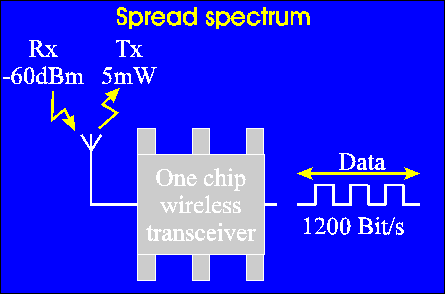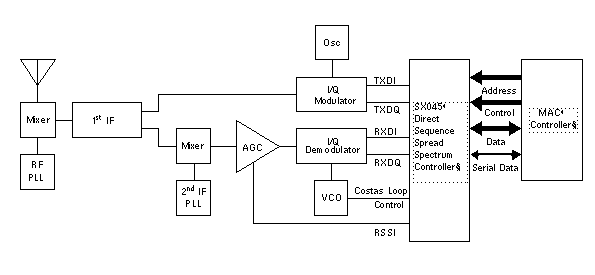Author's note: Spread Spectrum (SS) communications is not new to Ham Radio -- indeed,
Ham efforts go back to at least the early 1980's (see the ARRL Spread Spectrum Sourcebook).
Dedicated Hams, including Buaas and his STA (Special Temporary Authority) team have
recently paved the way for wider Ham Radio usage of this emerging technology.
TAPR's recent successful FCC request for changes to the FCC rules regarding
Spread Spectrum opens up amateur radio SS experimentation to a much wider,
organized group of very capable Hams. It seems that anyone interested may
join in TAPR's effort -- I hope that a lot of the world's Hams do join in.
The more folks supporting this effort, learning about this technology and
just plain "helping out" will ensure that Ham Radio enters the next millennium
equipped to stave off more commercial intrusions into our precious frequency bands.
Only by activities like this can Ham Radio stay alive, active and healthy.
TAPR has led numerous other efforts in Packet Radio, in Ham Radio's use of
DSP Techniques and providing a forum for experimentation, discussion and
camaraderie in the past. TAPR now will take the lead in getting Hams to
use SS techniques. I heartily congratulate TAPR on their success with
this STA and thank the society for their hard work! Best of luck AND
we would like to help you in any way we can.
This article presents the original work of Randy Roberts (KC6YJY, ex-WA6BFN)
regarding the subjects herein addressed. We hope
for a very successful outcome from TAPR's endeavors and we pray that Ham Radio
finally catches on and "Tunes In" to Spread Spectrum.
INTRODUCTION
Are you ready for it? Here is a real challenge for Ham Radio! TAPR's new Spread
Spectrum STA is a chance to radically modernize the way Ham Radio works, communicates,
and THINKS. By adopting a very enlightened position and pushing for technical progress,
TAPR is challenging Ham Radio to enter the 21st Century with a NEW SET of tools and
high tech capabilities.
How can you get ready for this STA? Hams have a very few choices to get on the
bandwagon with this new technology:
(1) Acquire commercial Wireless LAN or other commercial / military SS equipment,
modify it for Ham use and get going -- this may be the most expensive route, but
it's quick and can get the job done!
(2) Modify existing Ham Radio gear for SS capability -- perhaps a tricky and
sub-optimal approach.
(3) Design and develop new equipment designed from scratch to utilize SS techniques
-- probably the least expensive, but most time consuming route!
(4) Wait till the Japanese start marketing Radios with SS capability built-in --
easy, simple, but this could take a LONG wait!
My guess is that smart Hams like the folks in TAPR have already seen the wisdom
of choice number (3) and have joined forces to make a group effort in this direction.
I haven't read any announcements on this subject yet, but it is the most logical way
to go. I suppose we all must just wait and see what TAPR does in this this diection.
In the mean time, what do we do to utilize SS techniques?
As for approach (1) I can help some legitimate, organized group a little -- I have
a GRE GINA, 900 MHz DS 1 Watt radio (which I designed for them some 5 years ago) which
is fully functional that I would be willing to donate. Just email me some info about
your group and tell me how you plan to use it, first come - first served, since
there is ONLY one unit!
Approach (2) may be viable for a Ham (or a group of Hams) with significant DSP design
capabilities -- but most of us are probably just not capable of succeeding with approach.
I suggest that the BEST way for most of us to go is approach (3) -- design something new!
A new IC from Norway may provide a cheap, quick and dirty solution to "roll your own"
SS radio.

But, if 1200 bps is not fast enough and you want something more then we need to start with
a fresh, clean sheet of paper . . .
Another easily adapted SS chipset is the AMI WavePlex:

Of course, like many other commercial SS ICs on the market, the AMI chipset was designed
for the IEEE 802.11 standard! Is this the standard that Ham Radio needs and wants? I
personally don't think it is! So what do we do now?
Any time a new design is contemplated, a number of questions naturally arise:
- What should the new SS radio / modem do?
- What band should it use?
- Should it use DS or FH?
- What communication protocols should it use?
- What computer interface should it have?
- How much power, what bandwidth, what data rate, what channel coding, what modulation, . . . etc?
As you can see, some or all of these questions are very FUNDAMENTAL, if we really want
to COMMUNICATE with somebody else! In a nutshell, to exploit SS we need SOME STANDARDIZATION!
Over the years Hams have evolved standards for SSB, CW, RTTY, SSTV, Packet, AM, Satellite,
and other modes of communication. Some of these standards arose naturally through usage, some
came about from equipment manufacturers building "more or less standardized" radios and still
other standards were put forward by groups like TAPR. So isn't it natural to want to standardize
SS communications before we design, build or buy a bunch of new equipment?
HAM SS COMMUNICATIONS STANDARDIZATION
With TAPR taking the lead role on this STA, I strongly believe that standardization will
happen. Part of TAPR's SS team has experience helping to define the IEEE 802.11 Wireless
LAN standard. Thus, if any group is capable of setting a standard for Ham SS, TAPR is!
This standardization effort should be done before there is any real widespread Ham Radio
use of SS -- otherwise, SS hams may just be talking to themselves!
OK we need to standardize -- but, on what modes, on what applications and at what
level of detail? SS communications is quite a bit different than the standard existing
modes of amateur radio communications. SS has characteristics that make it more like an
extended set of radio (or on the air) interfaces along with something like packet radio
parameters. Both the SS on the air characvteristics AND the various SS layers of OSI-like
protocols and "layers" need to be specified to make a standard useful. I'm no expert at
the OSI-layer definition, but I can offer a few thoughts on the other side of on the air
SS characteristics.
I strongly feel that an "open" standard should be adopted. By this I mean that
any standard set for Ham Radio SS should allow for a multitude of applications from
replacing slower speed packet radio communications, to Internet / WWW communications,
to digital voice, to very narrowband communications for satellite and EME. In short,
a new SS standard should allow for a range of on the air parameters, various modes of
communications and various data rates / modulation schemes. While no one radio (or
SS radio / modem) may ever be designed to do everything in the standard, the standard
should encompass:
(1) Data rates from a few baud to perhaps 250 kbps.
(2) Occupied (-20 dB bandwidth) RF bandwidths from 1 kHz to perhaps 3 MHz.
(3) BPSK, DPSK, QPSK, DQPSK, OQPSK, GMSK, FSK, and perhaps other carrier modulations.
(4) Direct Sequence (DS), Frequency Hop (FH) and Hybrid Pseudo Random / Pseudo Noise (PN) modulations.
(5) CDMA, FDMA, TDMA and hybrid combinations for multiple access.
(6) Optional features should include FEC, automatic message forwarding, use of repeaters,
interfaces to GPS / APRS and others to be determined.
I believe the standard should not limit what can be done with SS, but should be Open
enough to encourage experimentation, variants, offshoots, improvements and afterthoughts.
With this in mind, it is apparent that compiling, composing and maintaining this new
standard is a very big job! I am certain that TAPR (perhaps with ARRL help) is up to
the task. If we all support TAPR's efforts and lend whatever expertise and "sweat"
we can, then such a standard may stand the test of time and provide a real direction for
Amateur Radio SS in the future.
THE FUTURE OF HAM SS COMMUNICATIONS?
In the not too distant future, Ham SS operation may be as routine as Packet Radio
is today. But, we have a long way to go to get to that point, don't we? TAPR will
need everyone's help they can get to make this effort succeed. Ham radio needs to
make a committment for positive change, not just sit back with our aging communications
technologies. This committment for change is absolutely needed if we are not to see
our "exclusive" frequency bands auctioned out from under us! This commitment
means we all must do our part -- so join TAPR if you are not now a member, sign up to
participate in the STA if you haven't already done so and finally, quit talking about
change and do something to make it happen!
Randy Roberts, KC6YJY, ex-WA6BFN, El Granada, CA -- December 11, 1996
|